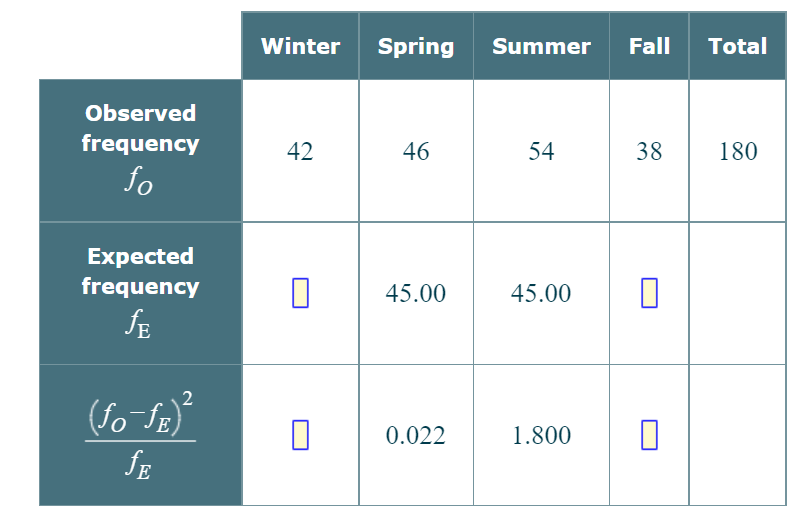ta were obtained from a random sample of 180 people. The birthdate of each person was recorded, and each of these dates was place ries: winter (December 21-March 20), spring (March 21-June 20), summer (June 21-September 20), and fall (September 21-Decembe ers in the first row of the table are the frequencies observed in the sample for these season categories. The numbers in the second row ncies under the assumption that birthdays are equally likely during each season of the year. The bottom row of numbers gives the follo of the season categories. (fo-JE)² JE t1 (Observed frequency - Expected frequency)² Expected frequency (fo in the missing values in the table. Round your responses for the expected frequencies to two or more decimal places. Round your decimal places
ta were obtained from a random sample of 180 people. The birthdate of each person was recorded, and each of these dates was place ries: winter (December 21-March 20), spring (March 21-June 20), summer (June 21-September 20), and fall (September 21-Decembe ers in the first row of the table are the frequencies observed in the sample for these season categories. The numbers in the second row ncies under the assumption that birthdays are equally likely during each season of the year. The bottom row of numbers gives the follo of the season categories. (fo-JE)² JE t1 (Observed frequency - Expected frequency)² Expected frequency (fo in the missing values in the table. Round your responses for the expected frequencies to two or more decimal places. Round your decimal places
Holt Mcdougal Larson Pre-algebra: Student Edition 2012
1st Edition
ISBN:9780547587776
Author:HOLT MCDOUGAL
Publisher:HOLT MCDOUGAL
Chapter11: Data Analysis And Probability
Section11.5: Interpreting Data
Problem 1C
Related questions
Question

Transcribed Image Text:Are birthdays "evenly distributed" throughout the year, or are they more common during some parts of the year than others? Owners of a children's toy store
chain asked this question. Some data collected by the chain are summarized in the table below.
The data were obtained from a random sample of 180 people. The birthdate of each person was recorded, and each of these dates was placed into one of four
categories: winter (December 21-March 20), spring (March 21-June 20), summer (June 21-September 20), and fall (September 21-December 20). The
numbers in the first row of the table are the frequencies observed in the sample for these season categories. The numbers in the second row are the expected
frequencies under the assumption that birthdays are equally likely during each season of the year. The bottom row of numbers gives the following value for
each of the season categories.
(fo-fr)²
JE
Part 1
(Observed frequency - Expected frequency)²
Expected frequency
Fill in the missing values in the table. Round your responses for the expected frequencies to two or more decimal places. Round your
responses to three or more decimal places.
(fo-fE)²
JE
Aa

Transcribed Image Text:Observed
frequency
fo
Expected
frequency
SE
2
(Jo-Jp)²
FE
Winter Spring
42
46
45.00
0 0.022
Summer
54
45.00
1.800
Fall Total
38 180
Expert Solution
This question has been solved!
Explore an expertly crafted, step-by-step solution for a thorough understanding of key concepts.
Step by step
Solved in 2 steps

Recommended textbooks for you

Holt Mcdougal Larson Pre-algebra: Student Edition…
Algebra
ISBN:
9780547587776
Author:
HOLT MCDOUGAL
Publisher:
HOLT MCDOUGAL

Holt Mcdougal Larson Pre-algebra: Student Edition…
Algebra
ISBN:
9780547587776
Author:
HOLT MCDOUGAL
Publisher:
HOLT MCDOUGAL